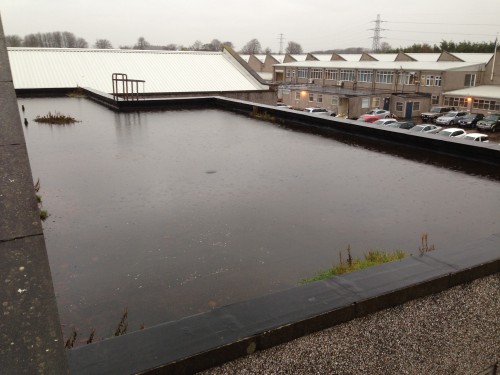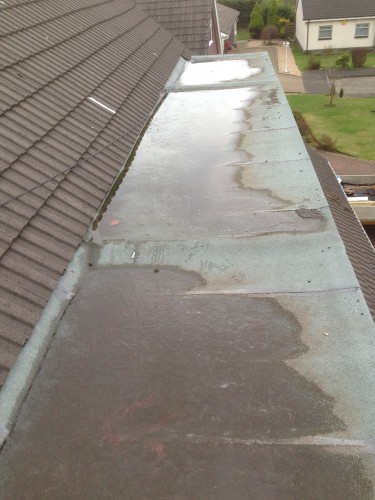Flat Roofs not Designed to Correct Falls
A ‘flat’ roof is never completely flat, in fact any roof is considered to be flat if the pitch does not exceed 10°. It is essential that water can drain efficiently from all areas of a roof. Although there are many design criteria to be considered when constructing a flat roof we are going to focus on the fall of the roof for this article. A fall in a roof can be created by sloping the top surface of the substrate by shaped insulation or screed or alternatively by sloping the entire substrate by using sloping timber fillets. Some guidance advises a fall of 1:60 for copper and zinc and 1:80 for felt and lead. However, to allow for construction inaccuracies the minimum fall for any flat roof should be 1:40 (i.e a fall of 25mm in every metre). The problem of sticking to the absolute minimum fall is that the water will tend to drain more slowly. Such a shallow fall is also more likely to experience ponding problems as the slightest unevenness will have an adverse affect on the flow of water across the roofs surface. It may seem a obvious thing to say but the fall of the roof should be towards the drainage outfall whether this be via a gully, valley or gutter. The drainage outlet should be placed at the lowest point of the roof. The correct size and positioning of the rainwater outlet is also important so that it can cope with the more severe weather without flooding. Particular care is also needed in detailing falls around rooflights and other obstructions.What is Ponding?
Ponding is where water collects in a puddle on the surface of the roof due to an unevenness in the roof covering or the substrate beneath. Ponding on the roof surface will rapidly expose any weakness in the design or construction due to the long periods of continuous wetting. Ponding can have a particular affect on felt roofs causing cracking due to irregular stresses. Also if a leak were to occur in an area where there was ponding then a much larger amount of water would make its way into the building compared to a properly drained roof. We have personally worked on industrial roofs that more closely resembled a swimming pool due to the poor water run off. Needless to say any leaks on these particular roofs lead to excessive water ingress.

Flat Roofing Solutions
There are many materials that can be used for flat roofs. A well constructed built-up felt roof will have a useful lifespan of 10 to 15 years, after which renewal of the covering will generally become essential. Occasionally a felt roof may last longer if its in a well sheltered location although poorly-constructed felt roofs often have a shorter life.
At Annandale Roofing we have certified installers of Firestone and GRP systems in our team and it is these systems we tend to advise clients on using. Both systems boast a life expectancy of over 50 years so this gives a real value for money compared to other systems on the market. Sometimes people do not think about the long term benefits of a particular system, they will just base their decision on the initial cost alone. For example it would be cheaper to lay new felt over an existing defective felt roof rather than stripping it and using say, Firestone. However overlaying with felt will only provide a short to medium term solution. So when you compare these two methods over there respective lifespans then Firestone will be massively cheaper.Example
A particular example I have seen recently is a roof that had felt applied over the existing felt roof covering. The roof had extensive ponding and was not running to the rainwater outlet. This system will probably last a few years at best before failing and initially save you a couple of hundred pounds compared to Firestone or GRP. But when you consider the costs over a 5 year period you would have actually saved hundreds of pounds using Firestone or GRP and over a 50 year period the savings would be into the thousands.

Flat roofs not designed to falls can be a common mistake and will reduce the life expectancy of your flat roof. At Annandale Roofing we ensure all of the design issues are considered to make sure you get the best value out of your flat roof whilst delivering the highest quality roofing solutions.

